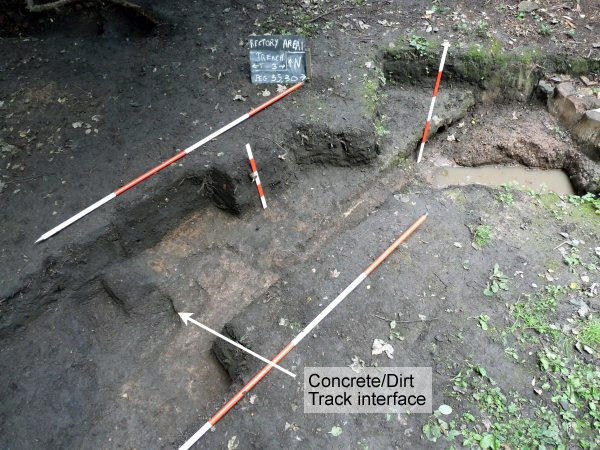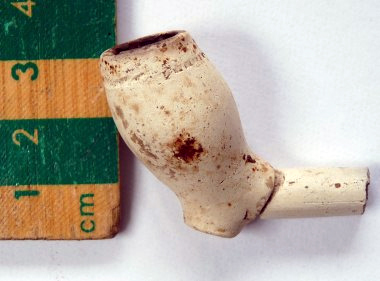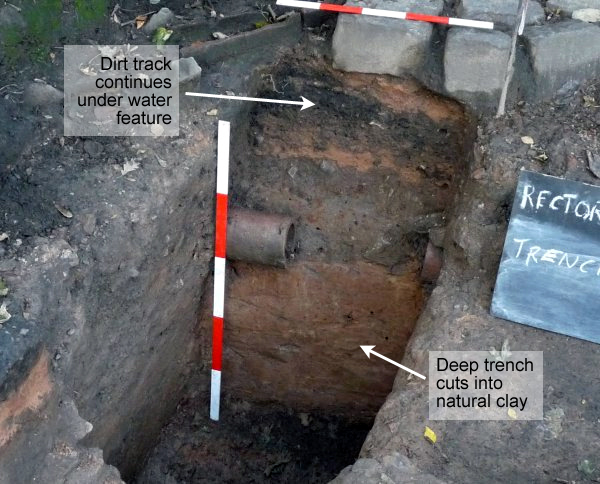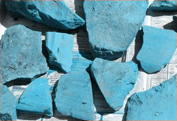
Excavations in our first area at the Rectory are nearing completion, having now achieved our primary goal (i.e. finding and establishing the nature of old Frog Lane).
Our latest trenches confirm that the road was constructed in two parts in this area. The main part (which continues on to the west) is made from gritty pit dirt, compacted to render it almost impervious to even a pickaxe. It's thickness on average is 10cm and it lies on a thick bed of course sand. On the south side the sand changes to a band of compacted sandy dirt, which may have been an earlier path. Cutting through this (but not through the road itself) is clay filled trench containing an iron pipe. This runs parallel to the road but as yet we have no idea of its purpose.
 As the road approaches the turn into Hallgate (towards the east), it changes quite abruptly into the second part. This can only be described as a concrete raft extending across the full width of the road. It may have been put down as a repair as the ground surface here is quite soft consisting backfill, indicating that a large pit had been dug here at some point. Subsequent settling has occurred causing cavitations under the concrete. As the road approaches the turn into Hallgate (towards the east), it changes quite abruptly into the second part. This can only be described as a concrete raft extending across the full width of the road. It may have been put down as a repair as the ground surface here is quite soft consisting backfill, indicating that a large pit had been dug here at some point. Subsequent settling has occurred causing cavitations under the concrete.
From the few pieces of pottery recovered from the road layers it's difficult to put a date on its construction; however the iron pipe seal below its surface suggests nothing earlier than the late 18th century.
Lying in the centre and sealed by the road layers (as mentioned in our previous newsletter), is a sedimentary ditch dating from the late 16th century. We initially thought this could be the reputed moat.
However its depth is only 45cm (1.5 feet) and with a width of no more than 1.8m (4 feet), this is unlikely (it could be, however, the ditch described by Sibson and others in the 19th century. It surrounding the whole town and Sibson thought it was Roman but others have suggested late medieval, which would fit nicely with our date).
Cutting through this ditch and the road itself, is a mysterious deep trench which we still haven't found the bottom of. Strange finds are coming out of it including a piece of iron stone. This material was mined extensively in the Douglas Valley towards the end of the 18th century for the Haigh foundry which was located down Leyland Mill Lane. Whether this piece comes from the Douglas valley seams is hard to say and there is no indication why it would be in our trench. Another find from near the bottom of the trench is this delicate clay pipe bowl. Clay pipes can be precisely dated and this one comes from 1650 (give or take 5 years). This doesn't fit with our sequence for the trench which probably means it came originally out of the sedimentary ditch. We are now about a metre down in this trench and probing suggests it goes at least a further 30cm. We still have no idea why it was cut, although there is a field drain on its north edge. Its shallow depth of 40cm suggests it is in a later re-cut and the fill looks more like building rubble than the soft clay fill in the rest of the trench.

We have not established the northern extent of the road yet but our latest test pit, on the northwest side of our main excavation, reveals the road extending well beyond the deep trench cutting through it. Final recording is underway (both planning and sectioning) and soon we'll be able to move on to our next area. There is a theory that the original entrance was not opposite Hallgate but further east nearer to New Market Street. This is quite possible as the rise to the Hall from the Hallgate entrance is far too steep. Much more likely coaches would have approached the Hall from the higher ground on the east side of it.
Much of this area has been destroyed by the Wigan Tech buildings but there is a chance some of the entrance survives in the east corner of the current grounds. This will be our next target.
Click here to view the excavation drawing.
Booklet Funding
As we all know Wigan's Roman Bathhouse was discovered in 2005 and dramatically changing the way people thought about Wigan in the earlier Roman period. Since then, however, only the official developer's report, produced by Oxford Archaeology North, has been published. It had always been agreed that a full-scale book would be produced for general consumption with funds supplied by the developer. Publication was deferred, however, so that the excavations in the Wiend in 2008 could also be included.
Unfortunately in the meantime Modus, the developers, went out of business leaving the book unpublished. Things came to a head, embarrassingly, earlier this year when the intended book launch had no book to launch. Ian however had always intended producing a small booklet along side the main book for use in schools, colleges and libraries. Its A5 format and full colour photos would provide a ready guide to the excavations of 2005 and 2008.
The cost of publication would be much less than the main book, so John O'Neil (chairman of the Greenheart Project) has offered to lend a hand - if we could help by applying for a grant from the Community Chest. Last month we did this and I'm glad to say our application has been successful. We now have enough funds for the booklet to be published and Ian has indicated that, if all goes to plan, the booklet could be out around Christmas, which is great news.
CBA NW Autumn Conference
This year's conference is to be held this Saturday (6th November) at the St Mary's Centre in Clitheroe. The theme this year is Museums and Lisa Keys will be opening with a talk on the development of our exhibition in the Museum of Wigan Life. If you are interested in going, details will be available at the next meeting.
Next Meeting
Wednesday 3rd November in the concert room of the Upper Morris Street Working Men's Club (off Greenough Street), starting at 7.30 pm as usual.
Caer Alyn is an Iron Age hill fort just north of Wrexham. It was here in the early 80's that I had my very first archaeology experience when I attended a WEA fieldday. In the last few years Phil Cox and his team have been continuing the tradition with a heritage project aimed once again at volunteers in the community. At our next meeting Phil will explain some of the successes of this wide ranging project. In the meantime, if you want to learn more about the project the website is: http://www.caeralyn.org/.
Hope to see you at the meeting - BA
|



